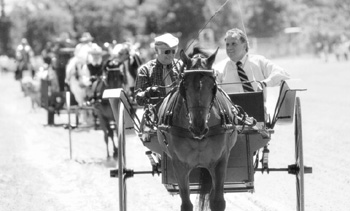 Sporting Life: Chesapeake Horse Sense
Sporting Life: Chesapeake Horse Sense Sporting Life: Chesapeake Horse Sense
Sporting Life: Chesapeake Horse Sense
Maryland's third biggest industry runs on love as well as money.
by Aloysia C. Hamalainen
photos by Isabel J. Kurek Lee
Sadler, above, drives Sen. President Mike Miller in a Westchester cart drawn
by 24-year-old Morgan mare C. S. Pearlstone. At left, Maryland-National
Capitol Park Police officers Sheri Severn and Jeffrey Clagett.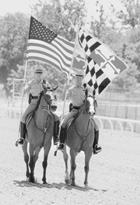
The accountant on the bus sitting next to you is one. So is that woman reading a magazine. The lady in line at the grocery with three bags of carrots is one. So is the little girl in braids, tight pants and leather boots. You may share a trail along the Patapsco River with a bunch of them. Your lawyer may be one. They look just like you, and you and of course me, because I am one.
They are Horsey People. And we are everywhere.
Most definitely in Maryland, where the horse industry produces goods and services valued at $614 million, according to a 1996 study by the Barents Group for the American Horse Council. The horse's impact on the Maryland economy is $1.5 billion and, the researchers estimate, "82,900 Marylanders are involved in the horse industry as horse owners, service providers, employees, and volunteers. Even more participate as spectators."
I think it's more than that, but I am biased.
Another study, by the Maryland Equestrian Foundation, calls the horse industry the third largest industry in Maryland and our largest agricultural industry.
And that's not all.
Maryland's 255-year-old horse racing industry includes "over 900 horse farms, contributes more than $1.2 billion each year to our economy, employs about 17,000 Marylanders and preserves over 250,000 acres of open green space from development," wrote Joseph De Francis, president of the Maryland Jockey Club, in an "Open Letter to Maryland Taxpayers."
Well, as they say, that ain't hay.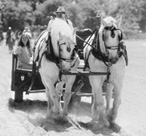
It is horse feed, shoes, saddles, trailers - you get the picture. The immense web of services providers and takers makes the horsey world an almost invisible solar system, with this four legged animal the center around which it all revolves.
photo by Isabel J. Kurek Two tons of Percheron, Topper and Tracy, driven by James Thomas, at right.
Perfect Matches
 photo by Denise Hubbard Dory
Wiseman rides Hip Hip Hooray to junior Pony Race victory.
photo by Denise Hubbard Dory
Wiseman rides Hip Hip Hooray to junior Pony Race victory.
There is probably only one tenet that this slice of the world's population can agree on, and it is this: "There is nothing better for the inside of a man -- or woman -- than the outside of a horse."
Every other aspect of horsemanship is purely a matter of taste. Humans have manipulated the equine physique to suit their every need and desire. Taking the three basic "flavors" - "hot blood" from the Arabian breed developed by Bedouin tribes in the Saharan desert for their stamina and speed; "cold blood" in the large, draft breeds originating from northern Europe; and the pony, smaller and with different proportions - horses have been mixed and blended over three thousand years until we have at least two hundred breeds.
Horses bred in Maryland range from the ubiquitous quarter horse to the exotic American Bashkir curly. Stallions of at least 40 breeds are advertised for stud by members of the Maryland Horse Breeders Association. How many more breeds live unadvertised lives here is almost impossible to know. The equines range in size from the diminutive miniature horse ---which stands about two feet high at the withers, or shoulder - to the massive Clydesdale, which goes as high as 19 hands, or over six feet.
The mascot of the Eastern Shore of Maryland is the Chincoteague pony. Bands of feral ponies whose origins are lost in haze of historical myth survive on windswept Assateague Island, aided by Fish and Wildlife Service and the Chincoteague Volunteer Fire Department. Every year, to raise money to maintain the ponies and to thin the herd, the ponies are swum ashore and sold at auction. They make good children's ponies; many have gone on to stellar show careers.
The uses of the horse are as numerous as the breeds. Now that the horse is not needed simply as an engine, humans have devised a myriad of sports and games so we can play together. Over the past 20 years with the development of therapeutic riding, the horse has changed the bodies, and minds, of physically disabled people. Thus, in a circle of sorts, we use the horse not to get somewhere but to be something.
How does the horse feel about all this? In the 40 years I've shared with horses, I've figured some things out. Horses are like a cross between cats and dogs: they are patient and accommodating and willing, like a dog, but they are independent and have minds of their own, like a cat. They are herd animals, and it is in their genes to cooperate, listen and obey. But they also have a strong sense of self-preservation, and their best defense is to bolt and run.
In other words, they will jump, run and dance for you - if you ask them. You can't tell them anything. For horsey people, the asking is the challenge. This is not just a hobby you can pick up and put down. This is a way of life. More importantly, it is not a cult or a religion; it is a passion. This passion is most intense when the horse and human connect and achieve their goal. It's as simple as that, and as hard as that. Many devote the better part of their lives working to achieve goals that include, in some way, a horse.
And they can take your breath away.
Out on the cross-country course, a horse thunders by, launches himself over the mountain of logs into the pool, splashes through and gallops on to the next obstacle.
In the middle of a ring, a braided and shiny gray pony with a tiny rider
meticulously negotiates the fences made of fake flowers and colored poles.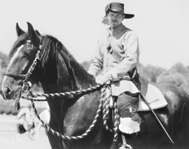
With two volunteers alongside, a soft-eyed quarter horse walks carefully as his impossibly crumpled rider laughs, then reaches curved fingers to stroke his neck.
photos by Isabel J. KurekA member of the Medieval Horse Guild group.
Horses on Parade
The horse world is like the ocean, where schools of fish swoop and glide. At around 6am on the weekend on any given crossroads on the outskirts of town, you will see horse trailers driven feverishly (it seems you are always running late) in all directions. The trail people are off to a 25-mile ride, the dressage people to a schooling show, the hunter people to an "A" show for points. Later in the day, moms are taking their children to Pony Club, a pleasure rider is meeting up with some pals for a jaunt on a rail-trail. There's just about something for everyone in every county during the summer show season.
Perhaps the most disconcerting thing about showing in Maryland is that you may be competing against an Olympic rider or two. Because the horse shows and horse trials are so well run and so numerous here, riders on the U.S. Equestrian Team compete their young horses in novice divisions, while their seasoned veterans go in the higher levels. But they had to start somewhere, and their first teachers were the same as for us all - the school horse.
At Woodland Horse Center in Silver Spring, in the middle of a dusty arena, a beginner class of six riders is starting. It looks like bumper cars with hooves. Satin doesn't feel like leading the line. Jack, the pony, wants to bite big Snowball for crowding him; Lacey is pushing against Brownie, who doesn't like it and is backing up. Michelle McCarron, the unflappable instructor, calls to the group, "Come in the middle so we can talk about a few dangerous situations I see."
She explains to the frustrated kids how "each horse is different" and gives strategy to keep the peace. A quick re-sorting and Jack becomes the leader, then Lacey and Snowball and on down, with Brownie in the rear. A mannerly line of trotting horses and ponies. With lots of "very nice," "excellent!" and "heels down and sit up," each child is carefully watched and noted.
After the lesson, when everyone leaves smiling, I talk to McCanon about her vocation. "I think riding lessons are a big help in raising children today," she says. "It gets them interested in doing something outside, with nature, and gets them out of the malls."
On a recent Saturday, you could have seen many of the different directions horse training leads at Prince George's Equestrian Center, where Maryland Association for the Preservation of Equestrian Sports celebrated "Horses in History."
There were races: pony, mule, trotting and running and the world's first racking. There were breed exhibits: Arabian; paso fino, which means "finely moving feet," so named because their legs appear to move as quickly as egg beaters; Tennessee walking; Morgan. There were sports: carriage driving, fox hunting, trail riding. There were special interests: medieval jousting, armor, Civil War reenactors.
Diverse as Horsey Maryland is, everybody knows each other - sort of.
photo by Kim Cammarata While
the racing industry has fallen on hard days ...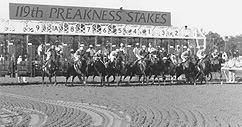
"The horse world is a small world," says Cindy Withers, a member of Chesapeake Plantation Walking Horse Club. "You can be driving your horse trailer somewhere, and you pass someone driving their trailer. You all smile and wave, even though you don't know who they are."
As is typical of horse owners, Withers belongs to more than one of Maryland's legion of horse-oriented clubs: Trail Riders of Today (TROT), Plantation Walking Horse Club and the League of Maryland Horsemen as well as the Chesapeake Plantation Walking Horse Club. The average membership is three or four groups.
That's only a start. There are clubs and associations for every interest and discipline. The Internet web site, Baltimore Horse County Resources at www.bcpl.net, lists over 70 organizations, among them the Amateur Jousting Club of Maryland, American Miniature Horse Association, Maryland Combined Training Association, Maryland Horse Shows Association, Master of Foxhounds Association, Medieval Horse Guild, Plantation Driving Club, Potomac Valley Dressage Association, United States Polo Association and the United States Pony Clubs. I know that's not all, because a couple I belong to are not listed.
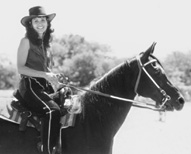 photo by Isabel J. Kurek. ...
"ones and twosy" ridership is growing, as represented by Cindy
Marson.
photo by Isabel J. Kurek. ...
"ones and twosy" ridership is growing, as represented by Cindy
Marson.
With only nominal dues ---$10 for many of them -- these clubs and organizations offer weekly or monthly seminars and get-togethers. At pot-luck dinners or family restaurants or hands-on in a stable or arena, members learn up-to-date medical and training information or time-honored approaches to common problems. Newcomers gain confidence amid easy camaraderie in a forum where everyone has an opinion but most ears are open to listen.
The major appeal of the riding clubs, of course, is the opportunity for members to ride, or drive, together. For example, the Chesapeake Plantation Walking Horse Club, originally formed to advocate the walking horse breed, welcomes all and "invites enthusiasts of all breeds and riding styles to join in our fun." TROT has a year-round calendar of trail rides all over the state.
Horses have a central role in all these groups, but just what role depends on the organization. In some, like the medieval armor folk, the horse is just a small part of the group's wider interest. In others, like the Plantation Driving Club, the horse is the engine that drives the club. For the breed groups, like the Miniature Horse Association, the horse is the group's reason for being.
A rising star of riding groups is the civilian patrol and search and rescue unit. Trained teams are on call whenever a child - or adult - gets lost in a national park. The civilian mounted patrol, on the other hand, ride the trails of the parks as auxiliary "eyes and ears" for the park police. Geneva Loczi, recently honored for her five years with the National Capital Park Police Civilian Mounted Patrol, calls it "Pleasure riding with a purpose. I love dealing with the public, and of course, the kids love the horses."
In five years, Loczi's work has remained purely pleasure. "I'm happy to say I've never had to call in a crime," she told me. But, she added, "once a rollerblader fell and needed medical assistance, and I was able to call in help for her."
Anatomy of a Positive Addiction
photo by Isabel J. Kurek Maegan
Boerckel with donkey Eeyore, her sister Kristin and Ashley Frost behind.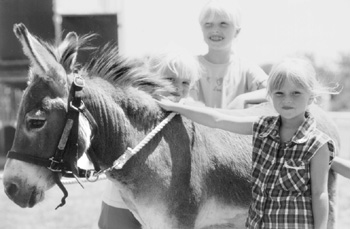
When Jane Gallino's children were in school during the day, she decided she needed to do something. "I wanted to do something for myself that I would enjoy and was good exercise," she says. A friend offered to play tennis with her, but that wasn't it. The riding school was close to her house, so she decided to give lessons a try. And she loved it right away, right?
"Oh, no, I was scared to death of horses! You should have seen me trying to groom a horse. But I did it so I could get comfortable, and I made some friends--- horsey friends. And I liked the horses." She tells me this as she scrubs her mare, Cajun, in the Woodland Horse Center wash stall, rubbing some purple goo into her bay coat so she will shine at the horse show tomorrow.
"And then my daughter wanted to take lessons, and we leased a horse, but that didn't work out. So we bought a horse," the horsey convert explains of a hobby that just kept growing. "We made a lot of friends, of all ages and with the same interests. It gives Paige, my daughter, and me something in common. We like it a lot," Gallino reports.
This little adventure is multiplied many times over, as yet another paying and contributing member of the horse world is initiated.
What do you spend typically on your horse, I wondered as we talked.
"Well," she reflected, hosing the goo off one side of the mare and rubbing it into the other, "we board at the barn and take lessons from a trainer. The farrier comes every six weeks and we use a vet. We buy riding equipment like saddles and bridles and clothes for us. We buy grooming supplies and vitamins. When we go to shows, we pay all the fees and food and stuff on the grounds.
"I'm thinking of getting another horse, and then we'll get a trailer. Then I'll need to get a bigger car "
To stop this reverie -- every horseperson has a wish list and everyone is afraid of totaling up the costs -- I wondered what groups she joined. Her list includes 4-H, Woodland Show Team, American Quarter Horse Association, Days End Horse Rescue and a therapeutic riding group. The Gallino mother and daughter also subscribe to several horse magazines and have purchased a permit to ride on the park trails. Yup, she's joined up.
Catering to Horsey Needs
You know that old saw, "don't look a gift horse in the mouth?" Every horseman knows that it's not the price of the horse that counts -- it's the day-to-day expenses. Since the costs are largely fixed, it costs about the same amount to keep a tiny pony as a Clydesdale four times its size.
Every horse and rider need these basic things: Feed and supplements; instruction; stabling, tack and equipment, including people clothing; a farrier to keep hooves in shape; and, most importantly, a veterinarian who is on call to reassure and to save.
To meet all those needs, a huge support network of small entrepreneurs and big business exists, ranging from local people who deliver, to 24-hour catalogues that can and do express mail that special piece of tack or vitamin ASAP. Each boarding farm and backyard owner has a favorite farrier and vet who make house calls on a regular basis. Hay is a good cash crop for farmers, and some specialize in horse hay.
"The Maryland horse industry is huge," says Heather Heider, of Southern States Cooperative Inc. Southern States used to make feed mostly for the dairy industry, but about 10 years ago they refocused on horses. "Now our whole bread and butter is the horse business," Heider says.
While the racing industry has fallen on hard days, "the ones and twosy horsemen are growing," Heider says, "and they spend money."
Such new feed lines are just what the doctor ordered for Debbie Poole, the owner of Belle Cote Arabian Farm in Burtonsville. "There used to be not so many types of feed to choose from, but now there is something for every type of horse," says Poole, who should know; her mid-sized breeding and boarding farm has been in business since 1969. "They have stuff for senior horses, babies and everything in between," Poole says.
When house hunting, as every country real estate agent knows, a horseman will look first at the barn, check its water and electrical, then the fencing and then, almost as an afterthought, look at the house. After all, you can live in any house, your horses have to have the right barn.
However, if you can't keep your horse on your property, there are a myriad
of boarding farms that run the full spectrum from horse cottage to palace.
At the one end are small, private or cooperative-style barns that offer
feed, shelter and a riding ring to a few. At the other are massive training
barns that can hold a hundred horses and boast jump courses, dressage rings
or indoor arenas. The price can vary from the basics for $100 or so to the
pampered existence of $500 a month. The August edition of The Equiery, an
equine newsletter, lists over 500 riding and boarding stables in Maryland.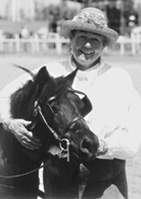
photo by Isabel J. Kurek Blair Hayes and her driving pony.
One of the many small entrepreneurs, Skeeter Cox, of Cox Trailer and Equipment Sales, "caters to all those people who go to all those horse shows." He sells trailers to hold from two horses up to 15, costing from $4,000 to over $125,000.
Tim McGrath has coined a word for his role in the horsey world: "Entre-manure." His Horsepower Farm Services expanded from his real estate business into a broadly diversified service: he sells the property, then insures it and hauls away the manure.
"It's the sport horse industry that's expanding, not the race horse industry," McGrath agrees. "Little Johnny or Sally get a pony and get into Pony Club. Mom and Dad hang around while they take lessons, and then they take lessons. They buy a horse and soon they start spending, say, $1000 a month and they decide to put that into a mortgage. So, I sell them the farm, and help with the insurance on it as well.
"Then, on these five acre farms, the homeowner doesn't know what to do with all the manure, so I have a manure removal service," says McGrath.
His business is about to expand further to include erosion and nutrient management for small farms. That's a service much in need in Chesapeake Country, where the counties are cracking down on water runoff from overgrazed fields and chemical imbalances caused by too much nitrogen coming from too much manure. McGrath's plan includes monitoring his clients' farms for soil erosion, especially where post holes bleed away hills, for composting manure in sanctioned areas and for making a soil additive that can be safely reused.
Like so many horsey people, McGrath combines pleasure with his business. Over the past decade, he's served as both president and vice president of Trail Riders of Today. McGrath has been all over the state as guest and participant in a variety of horsey activities from trail blazing to horse shows. "Every single horse discipline there is available, is here. You name it and we've got it," he says.
So what keeps someone a denizen in this expensive and time consuming world? For me, it's both the horses and the people. I think of the soft nicker and the velvet nostrils of my 23-year-old Arabian as he welcomes me to the barn or the exultant congratulations from my eventing friends as I clear the cross country course at a horse trial. Something for the soul and something for the heart.
Horse Fun A-Z
It's time for a pop quiz! What is Maryland's state sport?
Gotcha?
It's jousting, which is sort of like darts on horseback. The contestant, with or without armor and mounted on a horse, aims a spear with a long, pointed tip to the horizon, where metal circles hang from a series of stands. At a gallop, the rider attempts to spear the circles, which should then roll onto the tip of the spear. It gets harder as the circles get smaller, until the final circles are smaller than half dollars.
There are no franchise deals yet, but no stadium will be built, either.
Interested? Maryland State Jousting Championship, Diane Firth: 410/557-9189.
Here are thumbnail descriptions of more of Maryland's most popular horse sports. Who knows? You may want to try one.
Fox Hunting
photo by Isabel J. Kurek David
G. Raley leads his De La Brooke foxhounds to chase.
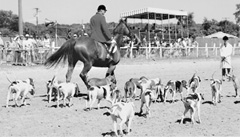
Back in 1650 when Maryland was young, Robert Brooke brought fox hunting to St. Mary's County. The De La Brooke Foxhounds still carry on that tradition.
Hunt clubs here follow an Americanized version, fox chasing, where the fun is in the tracking and pursuit and rarely is the fox killed. Hunt clubs also sponsor horse shows of the hunter variety and cap their seasons off with steeple chases and point-to-points. Many clubs welcome guests to sample the thrill of the chase for a "capping" fee.
The social scene in a hunt club is usually very active, and hunt clubs will often invite other hunt clubs to gallop together in joint meets. Many hunt clubs sponsor a chapter of Pony Club and other youth educational riding organizations. This is definitely a life style, as members are expected to participate in all aspects of the club, from keeping the land open to training the puppy hounds. Interested? De La Brooke Fox Hounds: 301/259-2275.
Hunter Shows and Circuit
Evolving from the hunt club shows is the type of riding called "hunt seat," which has to do with how the rider sits in the saddle and pilots a horse over a course of jumps. The whole impression is to appear effortless. The riding ranges from little kids on shaggy ponies kicking over logs to pristine thoroughbred horses ridden by the exquisitely tailored over jumps that could be in an art museum. There are the A, B and C circuits: guess which is which.
Professional riders spend most of the year riding horses costing many hundreds of thousands of dollars accumulating points for the three end-of-the-year horse shows, one of which, The Washington International, is based in Maryland. It is not as snooty as it sounds, and you can have a lot of fun. Sometimes you can even beat the big guys at their own game, and everyone is happy for you.
Interested? Combined Eastern Shore (Delaware and Maryland) Horse Shows: 302/945-0734.
Dressage
There is no jumping in this sport, which suits the courage-impaired of us nicely. Dressage comes from the word "to train" in French and was originally developed for horses carrying knights in combat. Those movements are seen today in only the highest levels, a stratosphere not many of us achieve. But dressage benefits horses in all sports, because it simply teaches the horse and rider how to move calmly, with strength and precision, utilizing the horse's natural gait and talent.
The shows, again on a recognized or schooling basis, are a series of tests ridden in a rectangle with specific points within which assigned movements are rated for their approach to the ideal. This looks to the observer like a horse being ridden in large circles and across the rectangle in a walk, trot or canter. The tests get harder and harder and go from level "Training" to "Fourth," with several tests in each. Above the levels are the superlative test, like Grand Prix where the horses seem to dance. A great development in the dressage specialty is the musical ride, or Kur, where the rider makes up the choreography and music.
Interested? Potomac Valley Dressage Assoc., Carolyn Del Grosso: 301/774-0794.
Combined Training
Considered to be the ultimate test of horse and rider, combined training is based on cavalry training. There are three phases: dressage, cross country and stadium jumping. Each rider completes all three phases and the one with the lowest penalty points wins. This sport is also on a level basis, ranging from super-chicken where the fences are a foot and a half and the dressage is walk-trot, to advanced, which takes three days, with its cross country over 25 miles with huge fences in the final two miles, with the dressage and stadium at high levels.
Interested? Maryland Combined Training Assoc.: 410/374-4799 (after 7pm).
Trail
This will appeal to all those who are not interested in the above. As Cindy Withers says, "It is a way to get outside and commune with nature and enjoy one of God's finer creatures."
Trail as a sport is a bit harder, though. There are pleasure trail rides, which are timed and judged treks over a set trail. The one who ends up at the right time and in the best condition wins. Competitive trail and endurance are over difficult terrain and can be up to one hundred miles long.
Interested? Chesapeake Plantation Walking Horse Club: 410/923-6157 or TROT at 301/588 TROT.
Carriage Driving
This ancient sport is enjoying a revival. Using from one horse up to eight, drivers in any of a whole range of vehicles compete in either a dressage-type setting or across country through obstacles. Team work, both of the human and horse variety, make all the difference. The equines range from tiny Shetland ponies to huge draft horses.
Interested? The Morgan Masterworks, Leitha Stone: 410/326-4758.
Therapeutic Riding
Hippotherapy, a form of occupational therapy developed over the past 20 years, means treatment with the aid of the horse. It is also called close to a miracle by all who have seen its benefits.
People with disabilities that range from cerebral palsy to spina bifida to autism are placed on a horse, and with the aid of volunteers holding them up, are walked around an arena or an outside trail.
Naomi Parry, executive director of Maryland Therapeutic Riding in Annapolis explains how the therapy works: "The movement of the horse's pelvis moves to the same pattern as the human gait, with three planes - up, down and sideways. As the rider sits on the walking horse, the movement is transmitted through the horse's back up to the rider's and provides a stimulation that is as if that person is ambulating.
"Their nervous systems are stimulated like they have never been before. Add to that the other effects that come from stimulating the other senses - touch, smell, sight and hearing - and their bodies get a workout more than they would get from any single physical therapy machine."
After training dressage horses for 20 years and certification as an advanced therapeutic riding instructor, Parry opened Maryland Therapeutic Riding some two years ago. The response was so great that this year she had to increase the size of her facilities. "The need is definitely there," she says.
The therapy is so effective, she says, because built in "is a motivation for the rider to continue therapy. They want to ride."
Making it all work is the horse. "Horses have a real magical way of interacting with the riders," Parry says. "They seem to know how important this is."
Susan Reno has been an advocate of progressive equestrian therapy since 1991, when doctors told her to take her multiple-disabled child to therapeutic riding. Christine was seven when she started, and for her and her family, the past six years have been a series of what her mother calls small miracles.
"Unlike part-time therapy, riding is much more absorbing," says Reno. Things started to happen quicker, and muscles strengthened as Christine had to reach over to stroke the horses and had to use both hands on the reins. She had to stretch her legs into the stirrups, and she developed an emotional connection to the horses by patting and grooming them.
"The riding skill, like balance, builds confidence and this confidence gives the rider pride in themselves," explains Reno. Interested? Naomi Parry, Maryland Therapeutic Riding: 410/267-8900.
| Back to Archives |
VolumeVI Number 33
August 20-26, 1998
New Bay Times
| Homepage |